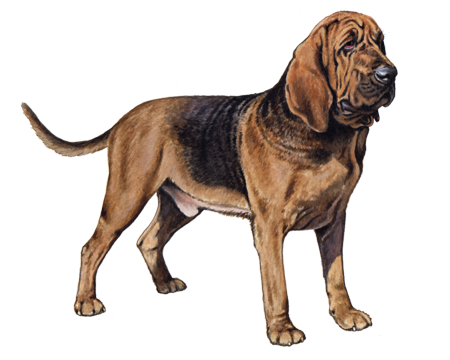
Basset Bleu de Gascogne
The Basset Bleu is a swift, agile hound dog with a keen nose. These dogs can hunt for long periods in all weather—after which they'll happily return home for a long nap on the couch! They love being part of a pack and prefer to spend most of their time with human or canine companions.
Interested in discovering if your dog is a Basset Bleu de Gascogne?
Check out Wisdom Panel's DNA tests.

Basset Bleu de Gascogne Traits
General Appearance
This breed has a typical Basset appearance: low to the ground and large, but not too heavy.
Coat and Coloring
The Basset Bleu de Gascogne has a short, dense, smooth coat. It's predominantly white and ticked with black, giving it a bluish appearance. Generally, black patches on either side of the head cover the ears, surround the eyes, and stop at the cheeks. This breed should always have tan points above the eyes, inside the ears, under the tail, and on the cheeks, lips, and legs.
Distinctive Physical Traits
The Basset Bleu's key features include a slightly domed skull, droopy lips, long, narrow ears, oval-shaped, sad eyes, a long neck and body, and short, strong legs.
Basset Bleu de Gascogne Temperament
These agile, adventurous, and curious dogs love the "pack life." They enjoy the companionship of other dogs and humans alike and make a great addition to the family. Because of their pack mentality, they don't do well when left alone for long periods. If their humans have to be away from home for long stretches of the day, they may do better with a canine buddy to keep them company. Though they're generally affectionate and lively, they can sometimes be reserved—particularly around strangers.
Bred for their excellent nose and strong hunting skills, these pups tend to spend a good deal of time with their face to the ground. And once they pick up a scent, it's challenging to keep them from following it. For this reason, it's best to keep your dog in a fenced area when they're off-leash to prevent endless wandering.
Basset Bleus are also known for their musical howls. These can be entertaining to their adoring family members, but close-by neighbors may not have the same appreciation.


Basset Bleu de Gascogne History
The Basset Bleu de Gascogne—or Blue Gascony Basset—comes from southwest France. The breed is a direct descendant of the Grand Bleu de Gascogne and has been around since the 14th century.
Some experts believe the Basset Bleu arose from a crossing between the Grand Bleu and the Saintongeois Basset. Others think the breed resulted from a spontaneous mutation within the Grand Bleu line—combined with selective breeding for shorter-legged dogs.
Regardless of the true origin, the breed was further refined during the French Revolution. Breeders sought to produce a rare combination of hound that was fast enough for horses but also slow enough for hunters on foot. Though the Basset Bleu sports a similar look to its close cousin the Basset Hound, its unique "blue" mottled markings and tan points set the breed apart.
The Basset Bleu neared extinction in the late 19th century, but Alain Bourbon brought the breed back to its current glory. The United Kennel Club recognized the Basset Bleu in 1991.
Basset Bleu de Gascogne Care
Nutrition
Basset Bleus need high-quality food appropriate for their life stage (e.g., puppy, adult, senior). Like all dogs, they're prone to weight gain if they overeat—and that can lead to other health issues. To help them stay at a healthy size, carefully measure out their meals, and limit treats to no more than 10% of their calories.
Because of the Basset Bleu's deep chest, this breed may be prone to bloat (also known as twisted stomach). To help prevent this life-threatening condition, break your dog's food up into several meals a day, and use a food bowl specially designed to slow their eating. When timing meals, avoid feeding your pup immediately before or after any vigorous activity. Ask your veterinarian about other ways—including surgical options—to prevent bloat.
Grooming
The Basset Bleu's short coat doesn't require a lot of grooming. Weekly brushing is usually enough to keep it free of loose hair and dirt.
Because of their long ears, Basset Bleus may be more prone to ear infections. Check their ears regularly for dirt or wax build-up, and clean them as needed. Nail trims and dental care—including at-home teeth brushing and professional dental cleanings—should also be part of their routine care.
Exercise
Basset Bleus are happy to spend much of the day napping on the couch, and they don't typically make great jogging partners. But they still require daily walks and opportunities to get outside and exercise their noses.
Training
Like most hounds, Basset Bleus tend to have a stubborn streak. This independent nature can make training a challenge. Patience, a gentle tone, and reward-based methods are the best tools for teaching this breed basic obedience commands.

Breed Group
Hound
The most common ancestral trait of this group is being used for hunting. Some use acute powers of scent to follow a trail while others demonstrate the gift of stamina as they run down a quarry. Beyond these two common traits, however, generalizations about hounds are hard to come by as the group is comprised of a very diverse lot of breeds.
Resources
http://www.fci.be/Nomenclature/Standards/035g06-en.pdf
http://www.vetstreet.com/dogs/basset-bleu-de-gascogne
Reviewed September 5, 2020 by Laura Inman, DVM


































